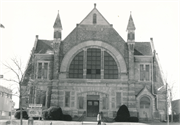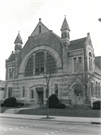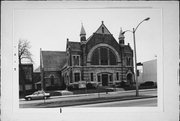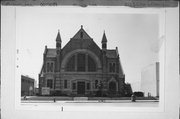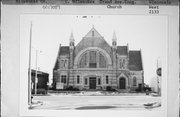Property Record
2133 W WISCONSIN AVE
Architecture and History Inventory
| Historic Name: | Grand Avenue Congregational Church |
|---|---|
| Other Name: | Irish Cultural and Heritage Center of Wisconsin, Inc. |
| Contributing: | |
| Reference Number: | 17089 |
| Location (Address): | 2133 W WISCONSIN AVE |
|---|---|
| County: | Milwaukee |
| City: | Milwaukee |
| Township/Village: | |
| Unincorporated Community: | |
| Town: | |
| Range: | |
| Direction: | |
| Section: | |
| Quarter Section: | |
| Quarter/Quarter Section: |
| Year Built: | 1888 |
|---|---|
| Additions: | 1907 1930 1935 |
| Survey Date: | 1984 |
| Historic Use: | house of worship |
| Architectural Style: | Romanesque Revival |
| Structural System: | |
| Wall Material: | Brick |
| Architect: | Edward T. Mix & Co. - 1888; H.a. Betts - 1907; Cornelius Leenhouts-1935; Van Ryn and De Gellke |
| Other Buildings On Site: | |
| Demolished?: | No |
| Demolished Date: |
| National/State Register Listing Name: | Grand Avenue Congregational Church |
|---|---|
| National Register Listing Date: | 1/16/1986 |
| State Register Listing Date: | 1/1/1989 |
| National Register Multiple Property Name: | Multiple Resources of West Side Area |
| Additional Information: | A 'site file' exists for this property. It contains additional information such as correspondence, newspaper clippings, or historical information. It is a public record and may be viewed in person at the Wisconsin Historical Society, Division of Historic Preservation. Another map code is 21/5. Locally designated: 3-27-1982. Choir/loft addition was designed in 1930 by Van Ryn & De Gelleke. DESCRIPTION: The Grand Avenue Congregational Church is a Romanesque Revival structure of pressed brick, rock-faced Wauwatosa limestone and Indiana cut stone. Third oldest of Wisconsin Avenue's remaining churches, Grand Avenue Congregational was built in 1887-1888 on what has been Milwaukee's premier residential street. The distinctive towerless facade is divided into three bays. The lower level is composed of alternating bands of brick and dressed stone while the upper level is of cream brick with windows accented with stone jambs, mullions and voussoirs. Two small side bays are separated from the large central bay by projecting spire-topped piers. The central gabled bay is dominated by a large Diocletian window of leaded glass. The main entrance, slightly recessed, is centrally located below this window. An additional, gabled entrance is located in the west bay. Grand Avenue Congregational is cruciform in plan and has a slate roof of steeply pitched, intersecting gables. The interior features a semi-circular auditorium with floors that slope gently down toward the pulpit platform on the south wall. Galleries are located on all four walls. Seating capacity is 1200, but up to 1500 persons can be accommodated. Beginning in 1907, various additions have been built to the rear including offices and rooms for various church functions. These do not mar the original church design. ARCHITECTURAL/ENGINEERING SIGNIFICANCE: Normally religious properties are excluded from listing in the National Register, but the Grand Avenue Congretional Church is being nominated for its local architectural significance. It is significant as an example of a Romanesque Revival church in Milwaukee designed by master architect Edward Townsend Mix. The majority of Mix's eclesiastical designs in Wisconsin are of Gothic derivation with towered facades and basilica plans. Grand Avenue Congregational, in contrast, is a highly original structure in the Romanesque style. Although Mix designed other structures in the Romanesque manner including clubhouses, Grand Avenue Congregational is one of his few churches in the style. Compared to his more Richardsonian ecclesiastical work, such as Milwaukee's St. Paul's Episcopal Church (1883-84), Grand Avenue is a startlingly original structure. Its abstracted facade composition and lack of a tower make it one of the more unusual of Milwaukee's major Victorian churches. HISTORICAL BACKGROUND: Grand Avenue Congregational was originally known as the Free Congregational Church and was founded in 1847 by a union of dissident members from the First Presbyterian Church and First Congregational Church. The new congregation had strong abolitionist sentiments and frequently extended their pulpit to traveling abolitionist speakers. The Free Congregational Church met initially in a rented building downtown on Broadway, between Mason and Wells Streets. Subsequent relocations led to name changes in 1852 (Spring Street Congregational) and 1881 (Grand Avenue Congregational). By 1887, the congregation was considering moving from its downtown location. Some members felt that a separate new congregation should be established at the western city limits and Grand Avenue Church should continue at its 6th and Wisconsin location. Others thought that the church should relocate further west since 930 of its parishioners lived west of 6th Street while only sixty (60) lived to the east. The majority ruled and a parcel of 120' by 176' was purchased on Wisconsin Avenue near 22nd Street for $13,200. Milwaukee architect E. T. Mix designed the approximately $59,000 structure which was dedicated in May of 1888. The building had a normal seating capacity of 1200 but up to 1500 people could be accommodated upon demand. Through the 1940s Grand Avenue's church auditorium was the largest of any Protestant church in the city. By 1903, Grand Avenue rnaked as the second largest of Wisconsin's Congregational churches. The church still houses its original congregation although it has dwindled in size in recent years. Grand Avenue Congregational has had a long history of social involvement. The Milwaukee Female Seminary for young ladies was founded by Pastor Parson's wife Lucy in 1848. The School eventually merged with Downer College of Fox Lake to form Milwaukee-Downer College in 1890. Congregationalism on the whole was responsible for founding more colleges in the United States in the early nineteenth century than any other organization. Temperance was required by the early convenants of the church and Grand Avenue Congregational took the lead in this cause in 1850 by hosing 1200 area residents in a protest against public drunkeness and violence. Members of Grand Avenue Congreational also started the Ladies Association for Aid of Military Hospitals in 1861 which grew into the city-wide Soldiers Aid Society of Milwaukee in 1862. This group was instrumental in the establishment of the National Soldiers Home at Wood, Wisconsin (VA Hospital today) after the Civil War. From 1894 through March 1899, Grand Avenue's West Side Literary Club sponsored entertainments that included essays, music, tableaux and constumed parties. Membership was open to all regardless of religious backgrounds. Attendance often reached 450 or more per meeting. Ecumenicism has long been an integral part of Grand Avenue's operation. In 1902 a joint Thanksgiving service, comprised of Christians and Jews, was held at the church. It was believed to be the first such service held in Milwaukee. In 1945 a joint service was held with the Black congregation of St. Mark's African Methodist Church. Grand Avenue has also provided meeting facilities for other religious groups temporarily without quarters such as the Finnish Congregational Church (1932) and more recently Central United Methodist (1980-82). (B, C). The Grand Avenue Congregation located at 2133 West Milwaukee Avenue commemorates Martin Luther King, Jr.’s visit here on August 14, 1957. The famed leader’s appearance at this site was sponsored by the Milwaukee NAACP, and was a means to advertise, inspire, and share the black struggle for civil liberties. The Executive Secretary of this branch, Mrs. Lucinda Gordon, was specifically credited with arranging his attendance. The time of the speech was reported to begin at 8pm, and all of the Church’s 1,300 seats were expected to be filled. King’s speech contained messages that addressed the elimination of segregation, the importance of peace and love, and the ability to act on finding a permanent solution to racial inequality. |
|---|---|
| Bibliographic References: | A. Milwaukee City Building Permits. B. Blix, Ovid B.; Dysart, Lulu; Gay, Greta; Reed, Anna; Stacy, Alice; Hughes, Mrs. Edgar. eds. "One Hundred Years of Christian Service 1847-1947." Grand Avenue Congregational Church, 1947. pp. 9,12,13,23,33,48,52. C. Boardman, Mrs. M. A. comp. "Historical Sketch Grand Avenue Congegational Church of Milwaukee 1847-1907." D. "Milwaukee Sentinel," November 23, 1886 3/1; January 31, 1887 8/1; February 12, 1887 3/1; July 8, 1887 4/5; 5/13/1888 11/6; May 14, 1888 3/1; 1/14/1935 (Leenhouts' obituary). E. Zimmerman, 233. F. Milwaukee Houses of Worship Survey. G. Shad, Mary Ellen, ed. "Milwaukee NAACP Brings Rev. Martin Luther King, Jr., Here." Milwaukee Defender [Milwaukee] 20 July 1957: 1. Readex. Web. 26 July 2016. |
| Wisconsin Architecture and History Inventory, State Historic Preservation Office, Wisconsin Historical Society, Madison, Wisconsin |

